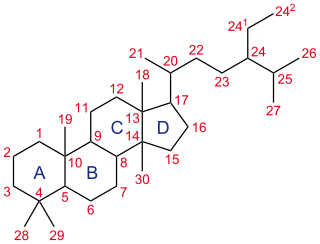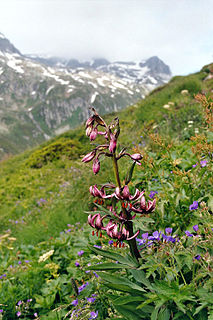
Asexual reproduction is a type of reproduction by which offspring arise from a single organism, and inherit the genes of that parent only; it does not involve the fusion of gametes, and almost never changes the number of chromosomes. Asexual reproduction is the primary form of reproduction for single-celled organisms such as archaea and bacteria. Many plants and fungi sometimes reproduce asexually.

Genetics is a branch of biology concerned with the study of genes, genetic variation, and heredity in organisms.

Nebuchadnezzar II, king of Babylon c. 605 BC – c. 562 BC, was the longest-reigning and most powerful monarch of the Neo-Babylonian Empire.

The lycophytes, when broadly circumscribed, are a vascular plant (tracheophyte) subgroup of the kingdom Plantae. They are sometimes placed in a division Lycopodiophyta or Lycophyta or a subdivision Lycopodiophytina. They are one of the oldest lineages of extant (living) vascular plants; the group contains extinct plants that have been dated from the Silurian. Lycophytes were some of the dominating plant species of the Carboniferous period, and included tree-like species, although extant (living) lycophytes are relatively small plants.

A steroid is a biologically active organic compound with four rings arranged in a specific molecular configuration. Steroids have two principal biological functions: as important components of cell membranes which alter membrane fluidity; and as signaling molecules. Hundreds of steroids are found in plants, animals and fungi. All steroids are manufactured in cells from the sterols lanosterol (opisthokonts) or cycloartenol (plants). Lanosterol and cycloartenol are derived from the cyclization of the triterpene squalene.

The lily family, Liliaceae, consists of about 254 genera and about 4075 known species of flowering plants within the order Liliales. They are monocotyledonous, perennial, herbaceous, often bulbous geophytes. Plants in this family have evolved with a fair amount of morphological diversity despite genetic similarity. Common characteristics include large flowers with parts arranged in threes: with six colored or patterned petaloid tepals arranged in two whorls, six stamens and a superior ovary. The leaves are linear in shape, with their veins usually arranged parallel to the edges, single and arranged alternating on the stem, or in a rosette at the base. Most species are grown from bulbs, although some have rhizomes. First described in 1789, the lily family became a paraphyletic "catch-all" (wastebasket) group of petaloid monocots that did not fit into other families and included a great number of genera now included in other families and in some cases in other orders. Consequently, many sources and descriptions labelled "Liliaceae" deal with the broader sense of the family.
Intellectual giftedness is an intellectual ability significantly higher than average. It is a characteristic of children, variously defined, that motivates differences in school programming. It is thought to persist as a trait into adult life, with various consequences studied in longitudinal studies of giftedness over the last century. There is no generally agreed definition of giftedness for either children or adults, but most school placement decisions and most longitudinal studies over the course of individual lives have followed people with IQs in the top two percent of the population—that is, IQs above 130. Definitions of giftedness also vary across cultures.

The Triple Goddess is a deity or deity archetype revered in many Neopagan religious and spiritual traditions. In common Neopagan usage, the Triple Goddess is viewed as a triunity of three distinct aspects or figures united in one being. These three figures are often described as the Maiden, the Mother, and the Crone, each of which symbolizes both a separate stage in the female life cycle and a phase of the Moon, and often rules one of the realms of heavens, earth, and underworld. In various forms of Wicca, her masculine consort is the Horned God.

In biology, adaptation has three related meanings. Firstly, it is the dynamic evolutionary process that fits organisms to their environment, enhancing their evolutionary fitness. Secondly, it is a state reached by the population during that process. Thirdly, it is a phenotypic trait or adaptive trait, with a functional role in each individual organism, that is maintained and has evolved through natural selection.

In archaeological cultures of North America, the classic stage is the theoretical North and Meso-American societies that existed between AD 500 and 1200. This stage is the fourth of five stages posited by Gordon Willey and Philip Phillips' 1958 book Method and Theory in American Archaeology.

In the classification of the archaeology of the Americas, the Post-Classic Stage is a term applied to some Precolumbian cultures, typically ending with local contact with Europeans. This stage is the fifth of five archaeological stages posited by Gordon Willey and Philip Phillips' 1958 book Method and Theory in American Archaeology.
- The Lithic stage
- The Archaic stage
- The Formative stage
- The Classic stage
- The Post-Classic stage

This is a bibliography of major works on the History of Canada.
Events from the year 1604 in Ireland.
Events from the year 1574 in Ireland.
Bergey’s Manual of Systematic Bacteriology is the main resource for determining the identity of prokaryotic organisms, emphasizing bacterial species, using every characterizing aspect.
Sarah Bowdich Lee was an English author, illustrator, traveller, zoologist, botanist, and pteridologist.
Roland Kenneth Harrison was an Old Testament scholar.

The high steward was an important official at the royal court in Ancient Egypt in the Middle Kingdom and in the New Kingdom. He was the main person in charge of the estates supplying the palace and the royal residence with food. The office appears in the 11th Dynasty. To the earliest title holders belong Henenu and Meketre. After the vizier and the treasurer this was the most important office at the royal court; important title holders of the 12th Dynasty were Siese and Khnumhotep III, both were later in their career appointed vizier.
The Mirror was a weekly broadsheet newspaper published from 1921 until 1956. It was the "scandal sheet" of its day, dealing with divorce cases and scandals.

The Cambridge History of Africa is an illustrated, eight-volume history of Africa published by Cambridge University Press between 1975 and 1986. Each volume is edited by a different person; the general editors of the series are John Donnelly Fage and Roland Oliver.














